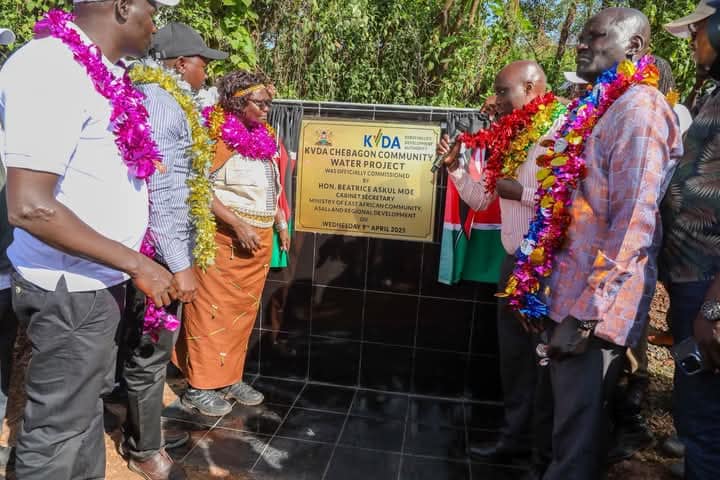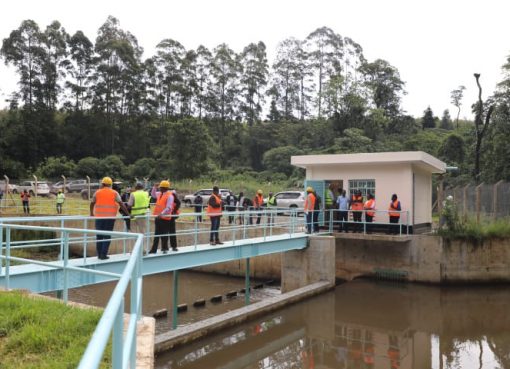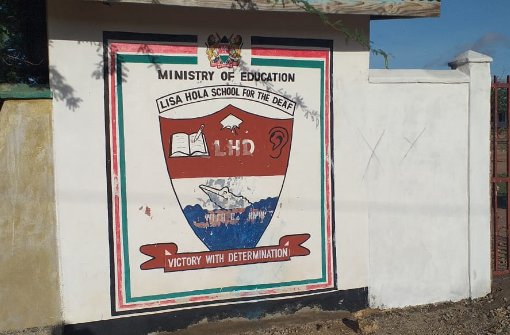The government has commissioned the Sh59 million Emsoo Dam and officially launched the sh 41 million Chebagon Water Distribution Network and School Greening Programme in Elgeyo Marakwet County, a move hailed as a significant boost to food security, household income, and environmental conservation in the region.
The Cabinet Secretary for East African Community, ASALs, and Regional Development, Beatrice Askul Moe, who presided over the commissioning ceremony, lauded the project as a partnership between the national government and the Elgeyo Marakwet County Government.
She underscored the need for water security to support agriculture, livestock rearing, and domestic use.
“Kenyans need water for many things—home consumption, food production, and for their livestock,” said CS Askul. “The County Government has done its part, and we are anticipating doing even more, including plans to install elevated tanks to serve households far from the water source.”
She further revealed plans for another dam project, to be implemented under the Kerio Valley Development Authority (KVDA), which will cost Sh100 million.
Governor Wisley Rotich welcomed the development, terming it a much-needed intervention in a region with great agricultural potential but constrained by water scarcity.
“This dam is a highly welcome project. Our challenge has always been water,” said Governor Rotich. “Our farms have suffered, and incomes have been low. I appreciate KVDA for the good job they have done and urge them to expand this support.”
The governor encouraged residents to make the best use of the water by planting income-generating crops. “Let us plant seedlings that will generate income for our households. I also urge KVDA to expand their support in terms of providing those seedlings,” he added.
Governor Rotich emphasized the need for conservation, noting Elgeyo Marakwet’s strategic importance as a water tower. “We supply water to almost 10 counties. The conservation of Elgeyo Marakwet is not only for our benefit but also for our neighbors.”
The projects launched include the Sh59 million Chebagon Small Dam and the Sh41 million Emsoo Water Distribution Network. Combined, these two projects will boost irrigated agriculture by an additional 1,200 acres and provide piped water to over 13,000 residents, schools, and hospitals in four sub-locations of Emsoo Ward. More than 20,000 livestock will also benefit from access to clean drinking water.
KVDA Managing Director, Sammy Naporos noted that the authority has implemented 12 water projects in Elgeyo Marakwet County, including dams, water pans, and boreholes, all aimed at improving livelihoods through irrigated agriculture for both subsistence and commercial use.
“The cumulative value of these projects stands at Sh364 million, benefitting over 15,000 households and 90,000 livestock,” he said. “Altogether, they have increased the land under irrigation by 1,400 acres, generating approximately Sh5 million per season from surplus food crops such as French beans, vegetables, maize, avocado, and mangoes.”
In tandem with water development, KVDA is also undertaking environmental conservation through a three-pronged approach that tackles poverty alleviation, climate change mitigation, and ecological restoration.
“As part of our efforts, we are distributing 200,000 tree and fruit seedlings in Elgeyo Marakwet alone. Across the region, we are targeting over one million seedlings,” the CS announced.
KVDA plans to grow three million assorted tree and fruit seedlings this financial year, with a focus on institutions, trust lands, catchment areas, and government forests. The authority is also encouraging schools to participate in the School Greening Programme by setting aside land for woodlot development.
“In the past five years, we have planted over 8 million tree and fruit seedlings. Increasing our forest cover is not just about the environment—it is about securing our water sources and building resilience against climate change,” said the CS.
She concluded that the commissioning marks a significant step in enhancing water security, agricultural productivity, and climate adaptation in one of Kenya’s semi-arid regions.
By Rennish Okong’o




